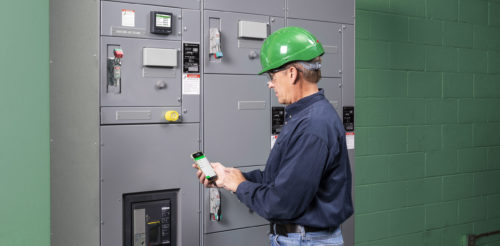Minimizing the risk of arc flash incidents
As employees work on or near energized equipment, movement near or contact with conductors or circuits, such as dropping a part or tool, may cause a phase-to-ground or a phase-to-phase fault. Also, an equipment failure that could produce a spark or arc could trigger an arcing fault. The resulting arc establishes plasma, which has a much higher degree of electrical conductivity than air.
|
As employees work on or near energized equipment, movement near or contact with conductors or circuits, such as dropping a part or tool, may cause a phase-to-ground or a phase-to-phase fault. Also, an equipment failure that could produce a spark or arc could trigger an arcing fault. The resulting arc establishes plasma, which has a much higher degree of electrical conductivity than air.
Once the arc plasma is established, it burns in air, providing a current path that conducts as much energy as the electrical power generation source can produce, and will continue to do so until protective devices react. The electrical conduction through this plasma creates a large amount of energy in a short period of time. The arc burns, vaporizing copper and other conductive materials, until an upstream overcurrent protection device opens to clear the fault.
This arc flash event is nearly instantaneous, and always extremely dangerous (Fig. 1). The energy produced by arc flash explosions has been compared to that of dynamite. An arc flash incident can produce temperatures much greater than 5000 F at the arc center and generate high pressures (arc blasts) that can destroy equipment and severely injure or kill anyone within the arc flash protection boundary.
Two types of shorts
Electrical short circuits are either bolted faults or arcing faults. A bolted fault is current flowing through bolted bus bars or other electrical conductors. An arcing fault is current flowing through the air. Because air offers impedance to electrical current flow, the arc fault current is always lower than the bolted fault current. Arcing occurs in both types. However, each behaves differently and requires different protection methods.
Arcing faults occur when electrical clearances are reduced or compromised by deteriorating insulation or human error, causing a conductive path among phases or phase-to-ground. Bolted faults occur when phases or phase-to-ground conductors are connected together. Generally, they are caused by mistakes made during installation or maintenance.
The upstream overcurrent protection device for a bolted fault opens quickly to protect the system. Arcing occurs inside the protective device as the contacts open. In circuit breakers, arcing and the resulting gases are vented through the arc chute to the breaker’s exterior.
Until recently, bolted fault current was the standard by which the effectiveness of electrical protection devices was measured. Now, extensive testing by the Institute of Electrical Engineers (IEEE) has quantified arc flash hazards in different types of equipment, leading to a better understanding of the difference between arc fault current and bolted fault current.
The importance of time
The difference between arcing faults and bolted faults is important. The time required to clear these faults perhaps is even more important. Traditionally, circuit breakers and fuses have been designed to disconnect very rapidly when the current reaches a specific bolted fault value, while allowing a time delay when current magnitude is at a lower value. But, since an arc flash occurs at a lower current level than the bolted fault, it is possible for these protective devices to allow greater arc flash incident energy at lower current values than at higher values. Incident energy is the energy dissipated during an arc fault, or arc flash event.
The knowledge about the difference in arcing faults and bolted faults, as well as the importance of the time required to clear them, is leading electrical equipment makers to consider a different approach to designing circuit protection systems that limit current at high values and interrupt current more rapidly at lower short-circuit current (arcing fault) values. By limiting incident energy, new equipment designs enable electrical workers to reduce the amount of protective gear they must wear if it becomes necessary to work on energized equipment.
Reducing the risk of arc flash
The best way to avoid an arc flash incident is to prevent it. Remove power and perform the necessary testing to ensure that power is absolutely removed from the area to be serviced by electrical workers. Don’t assume that a circuit is deenergized.
The following list offers guidelines to help avoid an arc flash incident:
-
Determine all possible sources of electrical supply
-
Open disconnecting devices for each source
-
Where possible, visually verify device is open
-
Apply lockout/tagout devices
-
Test voltage on each conductor to verify that it is deenergized
-
Apply grounding devices where stored energy or induced voltage could exist or where deenergized conductors could contact live parts.
-
However, it is not always possible or feasible to remove power before working on a circuit. OSHA 29 CFR 1910.333 states, “Live parts to which an employee may be exposed shall be deenergized before the employee works on or near them, unless the employer can demonstrate that deenergizing introduces additional or increased hazards or is infeasible.”
NFPA 70E further clarifies the preceding OSHA requirement. Examples of “additional or increased hazards” include the interruption of life support systems, emergency alarm systems, or hazardous location ventilation. Examples of “infeasible conditions” include startup testing, troubleshooting and diagnostics, or a continuous process segment.
NFPA 70E also offers guidelines for the level of protective clothing to wear when an arc flash hazard or potential is present. However, the guidelines do not take all variables into consideration. The only way to consider these variables, and possibly prevent disaster, is to do an arc flash analysis. Performing an arc flash analysis alerts you to the presence and location of potential hazards and provides accurate information regarding the minimum level of personal protection equipment (PPE) required.
NFPA 70E has developed workplace safety standards to minimize arc flash hazards and workplace deaths and injuries. The important aspects of compliance are:
-
Perform an arc flash hazard analysis on all electrical equipment. A one-size-fits-all approach can’t work because each plant is different. Arc flash analysis is an engineering study that determines the amount of current that could flow at any point in an electrical system, and the timing required for the nearest circuit protective device to operate to clear a fault.
-
Label electrical equipment designating the level of PPE a worker must wear when working on energized equipment.
-
Train workers and update work practice procedures to comply with the applicable standards.
-
Deploy work place policies, procedures, methods, and products to limit arc flash hazards whenever possible.
-
Equipment considerations
Fuses
Fused circuit breakers and fused switches using current-limiting fuses have long been recognized as a way to provide additional arc flash protection. When used with a circuit breaker, the fuse protects the breaker at fault current levels above the breaker’s interrupt rating. It provides quick clearing times during high-level short circuits and limits the amount of current available for the arc flash event.
In a fused switch, the fuse is the only overcurrent protection device in the circuit. A current-limiting fuse opens very rapidly at high current values in its current-limiting mode. For continuous current ratings of 400 A and lower, both fuses and circuit breakers provide very effective limitation of arc flash incident energy.
Fuses with current ratings of 400 A and below perform as well as circuit breakers. The incident energy and bolted current become significant for ratings from 400 A to more than 5000 A. The goal is to drive incident energy values down, so if an arc fault does occur, the level of heat and blast are minimized. For higher current ratings, current-limiting circuit breakers perform significantly better than fuses at lower current levels associated with arcing faults, and as well as fuses designed to operate at very high fault-current levels.
Fuses have relatively high thresholds of current limitation, compared with the lower instantaneous tripping levels of circuit breakers. This characteristic is valuable when fuses are used with current-limiting circuit breakers. In that case, the fuse is designed to not limit the functioning of the circuit breaker in low-level overcurrent conditions. A 1600-A fuse-limiter, typically used to protect 800-A circuit breakers, will not operate within the threshold of current limitation until about 32,000 A. But below that level, the fuse’s opening time is considerably longer than the
Circuit breakers
Low-voltage power circuit breakers traditionally have used magnetic forces within the circuit breaker to keep the contacts closed, allowing time for downstream overcurrent devices to open to clear a fault. As current flow increases, this “blow-closed” design increases the force keeping the contact assembly closed.
New current-limiting circuit breaker designs operate in a reverse manner, blowing open the terminal to interrupt the circuit (Fig. 3). This approach allows the circuit breaker to go into an accelerated opening mode, comparable to limiting fuses. At a slightly higher current, the circuit breaker goes into a full current-limiting mode.
The new circuit breaker designs also contain a filtered arc chute. An assembly of metallic grids and meshes significantly reduce the gases released during interruption of current. The grids deionize and cool the emissions, reducing the volume of vented gas, and absorbing up to 95% of the energy.
Retrofit or retrofill
Most circuit breakers will last at least 20 yr. However, older circuit breakers require closer maintenance attention to ensure that they remain functional. As maintenance becomes more frequent on aging equipment, the likelihood of incidents or equipment failures that could cause an arc flash also increase.
If there is an opportunity to upgrade equipment, existing circuit breakers can be replaced with current-limiting circuit breakers. Direct replacement options for low-voltage power circuit breakers provide a technology upgrade with minimal downtime (Fig. 4).
Another upgrade option is retrofill, where the existing switchgear cell is modified to accept the new low-voltage power circuit breaker. Each circuit breaker cell is reworked to allow installation of a current-limiting circuit breaker, cradle, racking mechanism, and new cell door. A retrofill also provides a technology upgrade. Usually, it requires a temporary main bus outage, although circuits supporting critical loads can be retrofilled in sections and temporarily rerouted during the procedure.
Removing workers from the hazard
Infrared windows and remote racking systems help keep workers out of the arc flash danger zone when equipment is energized. An infrared window, available from many manufacturers as a kit, can be installed in both low-voltage and medium-voltage distribution equipment to allow infrared inspections without removing panels.
Thermography is a valuable tool for preventive maintenance, allowing workers to determine load, connection, component fatigue, overheating, or phase problems without exposing themselves to hazardous conditions. An infrared window allows infrared electrical inspections to be performed at any time without downtime or danger of electric shock.
A significant percentage of arcing faults involving medium voltage circuit breakers occur during circuit breaker racking operations. A remote racking system allows racking and testing operations to be automatically controlled and monitored without direct human contact. A motorized racking mechanism can be retrofitted into each medium voltage circuit breaker cell. A programmable logic controller (PLC) initiates the racking and testing process, allowing racking operations to be performed from a safe distance outside the equipment’s arc flash danger zone.
The process of complying with the new NFPA 70E standards for minimizing arc flash incidents presents an opportunity to reexamine your electrical system and procedures, gain a better understanding of potential weaknesses, and instill new work practices to better protect employees and minimize financial risks to your company.
More Info:
If you have questions on arc flash, contact the authors. Joseph Weigel can be reached at 615-844-8656 or weigelj@squared.com ; Jonathan Clough, PE can be reached at 509-535-3685 or cloughj@squared.com . Article edited by Jack Smith, Senior Editor, 630-288-8783, jsmith@reedbusiness.com .
-
Do you have experience and expertise with the topics mentioned in this content? You should consider contributing to our CFE Media editorial team and getting the recognition you and your company deserve. Click here to start this process.




